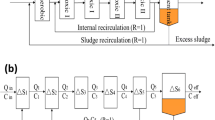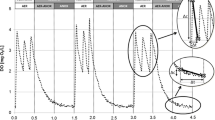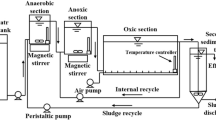Abstract
Wastewater treatment is an important source of nitrous oxide (N2O), which is a strong greenhouse gas and dominate ozone-depleting substance. The purpose of this study was to evaluate the effect of carbon source on N2O emission from anoxic/oxic biological nitrogen removal process. The mechanisms of N2O emission were also studied. Long-term experiments were operated to evaluate the effect of three different carbon sources (i.e., glucose, sodium acetate, and soluble starch) on N2O emission characteristics. And batch experiments, in the presence or absence of specific inhibitors, were carried out to identify the sources of N2O emission. The ammonia-oxidizing bacteria (AOB) and denitrifiers community compositions under different circumstances were also analyzed based on which the underlying mechanisms of N2O emission were elucidated. The conversion ratios of N2O in reactors with glucose, sodium acetate, and soluble starch were 5.3 %, 8.8 %, and 2.8 %, respectively. The primary process responsible for N2O emission was nitrifier denitrification by Nitrosomonas-like AOB, while denitrification by heterotrophic denitrifiers acted as the sink. Reactor with sodium acetate showed the highest N2O emission, together with the highest nitrogen and phosphate removal ratios. Carbon source has a significant impact on N2O emission quantity and relatively minor effect on its production mechanism.







Similar content being viewed by others
References
Adouani N, Lendormi T, Limousy L, Sire O (2010) Effect of the carbon source on N2O emissions during biological denitrification. Resour Conserv Recy 54:299–302
Ahn KH, Yoo H, Lee JW, Maeng SK, Park KY (2002) Acetate injection into anaerobic settled sludge for biological P-removal in an intermittently aerated reactor. Water Sci Technol 44:77–85
Ahn JH, Kim S, Park H, Rahm B, Pagilla K, Chandran K (2010) N2O emissions from activated sludge processes, 2008−2009: results of a national monitoring survey in the United States. Environ Sci Technol 44:4505–4511
Ahn JH, Kwan T, Chandran K (2011) Comparison of partial and full nitrification processes applied for treating high-strength nitrogen wastewaters: microbial ecology through nitrous oxide production. Environ Sci Technol 45:2734–2740
APHA (2005) Standard methods for the examination of water and wastewater, 21st edn. APHA, Washington DC
Bonin P, Tamburini C, Michotey V (2002) Determination of the bacterial processes which are sources of nitrous oxide production in marine samples. Water Res 36:722–732
Chandran K, Stein LY, Klotz MG, van Loosdrecht MCM (2011) Nitrous oxide production by lithographic ammonia-oxidizing bacteria and implications for engineered nitrogen-removal systems. Biochem Soc Trans 39:1832–1837
Enwall K, Philippot L, Hallin S (2005) Activity and composition of the denitrifying bacterial community respond differently to long-term fertilization. Appl Environ Microbiol 71:8335–8343
He Y, Inamori Y, Mizuochi M, Kong H, Iwami N, Sun T (2001) Nitrous oxide emissions from aerated composting of organic waste. Environ Sci Technol 35:2347–2351
Hu Z, Zhang J, Li S, Xie H, Wang J, Zhang T, Li Y, Zhang H (2010) Effect of aeration rate on the emission of N2O in anoxic-oxide sequencing batch reactors (A/O SBRs). J Biosci Bioeng 109:487–491
Hu Z, Zhang J, Xie H, Li S, Zhang T, Wang J (2011) Identifying sources of nitrous oxide emission in anoxic/aerobic sequencing batch reactors (A/O SBRs) acclimated in different aeration rates. Enzyme Microb Tech 49:237–245
Ibekwe AM, Grieve CM, Lyon SR (2003) Characterization of microbial communities and composition in constructed dairy wetland wastewater effluent. Appl Environ Microbiol 69:5060–5069
IPCC (2007) Changes in atmospheric constituents and in radiative forcing. In: Solomon S et al (eds) Climate change 2007: the physical science basis. Cambridge University Press, Cambridge, pp 114–143, Contribution of working group I to the fourth assessment report of the Intergovernmental Panel on Climate Change
Itokawa H, Hanaki K, Matsuo T (2001) Nitrous oxide production in high-loading biological nitrogen removal process under low COD/N ratio condition. Water Res 35:657–664
Kampschreur MJ, Temmink H, Kleerebezem R, Jetten MSM, van Loosdrecht MCM (2009) Nitrous oxide emission during wastewater treatment. Water Res 43:4093–4103
Kargi F, Uygur A (2003) Effect of carbon source on biological nutrient removal in a sequencing batch reactor. Bioresource Technol 89:89–93
Kim SW, Miyahara M, Fushinobu S, Wakagi T, Shoun H (2010) Nitrous oxide emission from nitrifying activated sludge dependent on denitrification by ammonia-oxidizing bacteria. Bioresource Technol 101:3958–3963
Kloos K, Mergel A, Rösch C, Bothe H (2001) Denitrification within the genus Azospirillum and other associative bacteria. Aust J Plant Physio 28:991–998
Liu S, Yang F, Xue Y, Gong Z, Chen H, Wang T, Su Z (2008) Evaluation of oxygen adaptation and identification of functional bacteria composition for anammox consortium in non-woven biological rotating contactor. Bioresource Technol 99:8273–8279
Muyzer G, de Waal EC, Uitterlinden AG (1993) Profiling of complex microbial populations by denaturing gradient gel electrophoresis analysis of polymerase chain reaction-amplified genes coding for 16 S rRNA. Appl Environ Microbiol 59:695–700
Noda N, Kaneko N, Milkami M, Kimochi Y, Tsuneda S, Hirata AMM, Inamori Y (2003) Effects of SRT and DO on N2O reductase activity in an anoxic-oxic activated sludge system. Water Sci Technol 48:363–370
Petersen B, Temmink H, Henze M, Isaacs S (1998) Phosphate uptake kinetic in relation to PHB under aerobic conditions. Water Res 32:91–100
Purkhold U, Pommerening-Roser A, Juretschko S, Schmid MC, Koops HP, Wagner M (2000) Phylogeny of all recognized species of ammonia oxidizers based on comparative 16 S rRNA and amoA sequence analysis: implications for molecular diversity surveys. Appl Environ Microbiol 66:5368–5382
Ratusznei SM, Rodrigues JAD, de Camargo EFM, Ribeiro R, Zaiat M (2003) Effect of feeding strategy on a stirred anaerobic sequencing fed-batch reactor containing immobilized biomass. Bioresource Technol 90:199–205
Ravishankara AR, Daniel JS, Portmann RW (2009) Nitrous oxide (N2O): the dominant ozone-depleting substance emitted in the 21st century. Science 326:123–125
Ritchie GA, Nicholas DJ (1972) Identification of the sources of nitrous oxide produced by oxidative and reductive processes in Nitrosomonas europaea. Biochem J 126:1181–1191
Robertson LA, Cornelisse R, de Vos P, Hadioetomo R, Kuenen JG (1989) Aerobic denitrification in various heterotrophic nitrifiers. Antonie Van Leeuwenhoek 56:289–299
Rusmana I, Nedwell DB (2004) Use of chlorate as a selective inhibitor to distinguish membran-bound nitrate reductase (Nar) and periplasmic nitrate reductase (Nap) of dissimilative nitrate reducing baceria in sediment. FEMS Microbiol Ecol 48:379–386
Shrestha NK, Hadano S, Kamachi T, Okura I (2002) Dinitrogen production from ammonia by Nitrosomonas european. Appl Catal A: Gen 237:33–39
Stein LY (2011) Surveying N2O-producing pathways in bacteria. In: Martin GK (ed) Methods in enzymology. Academic Press, Carolina, pp 131–152
Strohm TO, Griffin B, Zumft WG, Schink B (2007) Growth yields in bacterial denitrification and nitrate ammonification. Appl Environ Microbiol 73:1420–1424
Surmacz-Gorska J, Gernaey K, Demuynck C, Vanrolleghem P, Verstraete W (1996) Nitrification monitoring in activated sludge by oxygen uptake rate (OUR) measurements. Water Res 30:1228–1236
Tallec G, Garnier J, Billen G, Gousailles M (2006) Nitrous oxide emissions from secondary activated sludge in nitrifying conditions of urban wastewater treatment plants: effect of oxygenation level. Water Res 40:2972–2980
Tallec G, Garnier J, Billen G, Gousailles M (2008) Nitrous oxide emissions from denitrifying activated sludge of urban wastewater treatment plants, under anoxia and low oxygenation. Bioresource Technol 99:2200–2209
van Rijn J, Tal Y, Barak Y (1996) Influence of volatile fatty acids on nitrite accumulation by a Pseudomonas stutzeri strain isolated from a denitrifying fluidized bed reactor. Appl Environ Microbiol 62:2615–2620
Yoshinari T (1990) Emission of N2O from various environments-the use of stable isotope. In: Revsbech NP, Sorenson J (eds) Denitrification in soil and sediment. Plenum, New York, pp 129–149
Zeng RJ, Lemaire R, Yuan Z, Keller J (2003) Simultaneous nitrification, denitrification, and phosphorus removal in a lab-scale sequencing batch reactor. Biotechnol Bioeng 84:170–178
Zhu Z, Li T, Wang DS, Yao CH (2009) Effect of carbon substrates on the characteristics of activated sludge flocs. Acta Scien Circum 29:88–94 (In Chinese)
Acknowledgments
This work was supported by National Natural Science Foundation of China (21177075), Program for New Century Excellent Talents in University (NCET-10-0554), and National Natural Science Foundation of China (No. 21007032). We want to thank the anonymous reviewers for the constructive reviews. The comments are a great help to improve the quality of the manuscript.
Author information
Authors and Affiliations
Corresponding author
Additional information
Responsible editor: Hailong Wang
Rights and permissions
About this article
Cite this article
Hu, Z., Zhang, J., Li, S. et al. Impact of carbon source on nitrous oxide emission from anoxic/oxic biological nitrogen removal process and identification of its emission sources. Environ Sci Pollut Res 20, 1059–1069 (2013). https://doi.org/10.1007/s11356-012-1018-6
Received:
Accepted:
Published:
Issue Date:
DOI: https://doi.org/10.1007/s11356-012-1018-6




